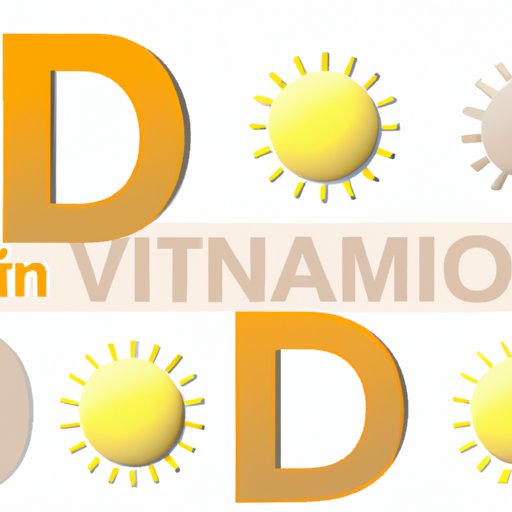
I. Introduction
Vitamin D is an essential nutrient that plays a crucial role in our overall health and well-being. It helps our bodies absorb calcium, which is needed for strong bones and muscles, and supports our immune systems, mental health, and heart health. While we can get some vitamin D from food and supplements, the best source of this nutrient is sunlight. In this article, we’ll explore how much vitamin D we can get from the sun, when and where we should sunbathe, and how to do it safely.
II. The Ultimate Guide to Getting Vitamin D from the Sun
The human body produces vitamin D when our skin is exposed to sunlight. UVB rays from the sun trigger a chemical process in our skin that converts cholesterol into vitamin D3, which is then converted into an active form of vitamin D by our liver and kidneys. The amount of vitamin D we can get from the sun depends on several factors, including the time of day, season, location, and skin tone.
The best time to sunbathe is during midday when the sun is highest in the sky, as this is when UVB rays are most concentrated. In general, the closer you live to the equator and the higher the altitude, the more vitamin D you’ll get from the sun. People with lighter skin tones also produce vitamin D more quickly than those with darker skin tones. However, it’s important to note that excessive sun exposure can have serious risks, including skin damage and cancer.
To safely get enough vitamin D from the sun, aim for 10-30 minutes of midday sun exposure on the arms and legs, or face and arms if you have darker skin, several times a week. It’s important to avoid burning, which can damage your skin and decrease vitamin D production.
III. Debunking the Myths: How Much Vitamin D You Can Really Get from the Sun
There are many misconceptions about vitamin D and sun exposure, including the idea that you can get enough vitamin D from sitting near a sunny window or getting sunburned. However, the truth is that most people do not get enough vitamin D from the sun alone, especially those who live in northerly latitudes or spend most of their time indoors. Additionally, people with darker skin tones or who wear clothing that covers most of their skin are more likely to have vitamin D deficiencies.
To meet vitamin D requirements, it’s recommended that adults get at least 600-800 IU of vitamin D per day. However, this can be difficult to achieve through sun exposure alone, especially during the winter months when the sun is weaker and daylight hours are shorter. Supplements or fortified foods can help ensure that you get enough vitamin D year-round. Talk to your healthcare provider for specific recommendations based on your individual needs and risk factors.
IV. Sunlight: The Natural Way to Get Enough Vitamin D
While supplements can provide vitamin D, getting it from the sun has unique benefits. Sun exposure triggers the natural production and absorption of vitamin D, which is preferable to consuming synthetic supplements. Additionally, spending time outside and engaging in outdoor activities have many additional benefits for overall health and well-being.
There are many ways to incorporate sun exposure into your daily routine, such as taking a morning walk or doing outdoor yoga. It’s important to prioritize safety, though, by wearing protective clothing and sunscreen, especially during periods of intense sunlight or if you have sensitive skin. Always be mindful of the risks associated with sun exposure and monitor any changes to your skin over time.
V. Why You Shouldn’t Rely Solely on Sun Exposure to Get Adequate Vitamin D
While sun exposure is an important source of vitamin D, it’s not the only way to get the nutrient, nor is it appropriate or safe for everyone. Factors such as your geography, lifestyle, and overall health can affect your ability to absorb vitamin D from the sun. Additionally, excessive sun exposure can have serious consequences, such as sunburn, skin damage, and skin cancer.
If you are unable to get sufficient vitamin D from the sun, there are other options. Foods such as fatty fish, egg yolks, and fortified milk and cereals can provide vitamin D, and supplements are also available. Consult with your healthcare provider to determine the best source and amount of vitamin D for your individual needs and health status.
VI. Exploring the Benefits and Risks of Getting Vitamin D from Sun Exposure
Getting adequate vitamin D is important for overall health and well-being, but it’s also important to understand the risks and benefits of sun exposure. While sun exposure can provide vitamin D and add to a healthy lifestyle, it can also increase the risk of skin damage and cancer. Balancing your time in the sun with other methods of obtaining vitamin D is necessary for optimal health.
It’s also important to consider individual factors such as skin type, age, and existing health conditions when deciding how much sun exposure is appropriate. Always prioritize safety, wear protective clothing and sunscreen, and monitor your skin for any changes. Consulting with a healthcare provider can also provide guidance and personalized recommendations for getting enough vitamin D.
VII. Conclusion
Vitamin D is an essential nutrient that has many benefits for our health and well-being. While sunlight is the best source of vitamin D, it’s important to balance sun exposure with other methods of obtaining the nutrient, such as diet and supplements. Always prioritize safety when sunbathing, and consult with a healthcare provider for personalized recommendations and guidance. Remember that getting enough vitamin D is just one component of a healthy lifestyle, and that small changes can make a big difference in your overall health.





